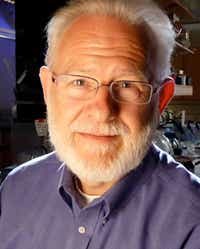David E. Nichols
| David E. Nichols | |
|---|---|
| Born | December 23, 1944 in Covington, Kentucky |
| Known for |
|
| Residence | United States |
| Nationality | United States (since 1994) |
| Occupation | Chemist, Psychopharmacologist |
| Fields | Chemistry, Pharmacology, Neuropsychopharmacology |
David Earl Nichols (born December 23, 1944, Covington, Kentucky) is an American pharmacologist and medicinal chemist.[1] Previously the Robert C. and Charlotte P. Anderson Distinguished Chair in Pharmacology at Purdue University, Nichols has worked in the field of psychoactive drugs and psychedelics research since 1969.
While still a graduate student, he patented the method that is used to make the optical isomers of hallucinogenic amphetamines. His contributions include the synthesis and reporting of escaline, LSZ, 6-APB, 25I-NBOMe and other NBOMe variants (25B-NBOMe, 25C-NBOMe, 25D-NBOMe), and several others, as well as the coining of the term "entactogen".
He is the founding president of the Heffter Research Institute, named after German chemist and pharmacologist Arthur Heffter, who first discovered that mescaline was the active component in the peyote cactus. He is considered to be one of the world's top experts on psychedelics.
Nichols's other professional activities have included teaching medicinal chemistry and molecular pharmacology at Purdue University in West Lafayette, IN, and teaching medical students at the Indiana University School of Medicine. He is currently semi-retired and holds a position as an adjunct professor at the University of North Carolina's School of Pharmacy, where he is affiliated with the Roth Lab.[2]
Education
- B.S. - 1969 - University of Cincinnati[3]
- Ph.D. - 1973 - University of Iowa
- Postdoc - 1973-74 - University of Iowa
Research areas
Nichols is still carrying out academic research on the chemistry of psychedelics. He has published approximately 250 scientific reports and book chapters, all describing the relationship between the structure of a molecule and its biological effects (often referred to as a structure-activity relationship, or SAR). He has done extensive work using the rat model assay of drug discrimination in characterizing hallucinogenic drugs.[4]
Although his research mostly uses rats, a number of compounds included in Alexander Shulgin's PiHKAL were actually first synthesized in Nichols's lab. His lab also first developed [125I-(R)-DOI as a radioligand.
Nichols is also one of the few people who have published legitimate research on the chemistry and pharmacology of LSD in the last 20 years, and first reported that several LSD analogues, including ETH-LAD, PRO-LAD, and AL-LAD, were more potent than LSD itself. Their human effects are described in TiHKAL. He also improved the synthesis of psilocybin so that it would be accessible for several recent clinical studies.
Other notable research he helped carry out includes extensive studies of the structure-activity relationships and mechanisms of action of MDA and MDMA, during which he helped to discover many novel analogues including such compounds as 5-methyl-MDA, 4-MTA and MDAI. Nichols has said that "he believes gray-market chemists used information from papers he published on 4-methylthioamphetamine (MTA) in the 1990s to synthesize the drug, which they sold in tablets nicknamed "flatliners" as a substitute for MDMA (Ecstasy)."[5]
More recently, Nichols has become one of the world leaders in research on dopamine, and his team has developed several notable dopamine receptor ligands, including the selective D1 full agonist compounds dihydrexidine and dinapsoline which have been researched for the treatment of Parkinson's disease. He co-founded DarPharma, Inc. to commercialize his dopamine compounds. Several of his team's compounds are now being studied in clinical trials for the treatment of Parkinson's disease and the cognitive and memory deficits of schizophrenia.
Impact on the designer drug market
Designer drug producers who scan scientific literature for information on compounds with potential grey market value have described Nichols' publications as an "especially valuable" road map to making new designer drugs. [6] Several deaths have been attributed to compounds that have been discovered in Nichols' lab, which he finds quite upsetting, "I was stunned by this revelation, and it left me with a hollow and depressed feeling for some time."[7]
Lectures and interviews
- LSD Neuroscience Nichols's lecture in Psychedelic Science 2013 conference.
- Advances In Understanding How Psychedelics Work In The Brain Nichols's lecture in the Psychedelic Science in the 21st Century conference in 2010.
- David E. Nichols interviewed by Jan Irvin (2010)
- From ‘there’ to ‘here’: psychedelic natural products and their contributions to medicinal chemistry (2017) Keynote speech delivered at the 50th anniversary of the "Ethnopharmacologic Search for Psychoactive Drugs" symposium.
- Oral history interview with David Nichols (Purdue Pioneers in Research Series)
Selected reading
Notable creations
See also
External links
- David E. Nichols (Wikipedia)
- Purdue University - Nichols
- Erowid Character Vaults: David E. Nichols
- Heffter Research Institute
References
- ↑ "The Heffter Review of Psychedelic Research, Volume 1, 1998 - 5. The Medicinal Chemistry of Phenethylamine Psychedelics by David E. Nichols, Ph.D" (PDF).
- ↑ Roth Lab - Members List | https://pdspdb.unc.edu/rothlab/members.php
- ↑ http://www.mcmp.purdue.edu/faculty/?uid=drdave | David E. Nichols, Ph.D., Robert C. and Charlotte P. Anderson Distinguished Chair in Pharmacology
- ↑ Jardri, R., Thomas, P., Cachia, A., & Pins, D. (2013). The Neuroscience of Hallucinations (pp. 262-263). New York, NY: Springer.
- ↑ Sullum, Jacob (2011-01-06) If Only There Were Some Way to Discourage the Marketing of Dangerous Substitutes for Banned Drugs..., Reason Magazine
- ↑ In Quest for 'Legal High,' Chemists Outfox Law (Wall Street Journal) | https://www.wsj.com/article/SB10001424052748704763904575550200845267526.html
- ↑ Nichols, D. (2011). Legal highs: the dark side of medicinal chemistry. Nature, 469(7328), 7-7. https://doi.org/10.1038/469007a
